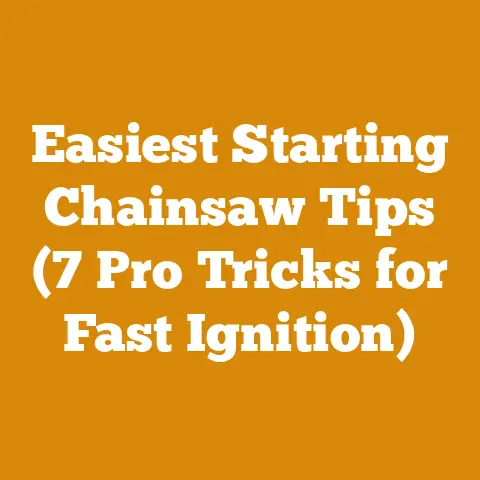How to Grow Hickory Nuts (5 Pro Tips for Perfect Germination)
Ah, the allure of hickory nuts!
Imagine yourself nestled in a luxurious armchair, a crackling fire in the hearth, and a bowl brimming with these delectable, buttery treats.
Growing your own hickory nuts isn’t just about food; it’s about crafting a legacy, a connection to the land, and a taste of genuine, homegrown luxury.
It’s an investment in something timeless, a future harvest of flavor and enjoyment.
This isn’t just about planting a tree; it’s about cultivating a tradition, a sustainable source of natural goodness, and a touch of rustic elegance in your life.
Let’s embark on this journey together!
1. Seed Selection and Stratification: The Foundation for Success
Choosing the right hickory nuts is the first, and arguably most important, step.
- Source Matters: I’ve learned over the years that the origin of your nuts significantly impacts germination rates.
Locally sourced nuts, adapted to your climate, generally perform best.
Contact your local agricultural extension office or a reputable nursery for recommendations on hickory varieties suited to your region.
Avoid buying nuts from unknown sources online, as viability can be questionable. - Variety is the Spice of Life (and Hickory Nuts): Different hickory species have varying nut sizes, flavors, and cold hardiness.
Shagbark hickory ( Carya ovata ) is a popular choice for its large, flavorful nuts.
Shellbark hickory ( Carya laciniosa ) produces even larger nuts but requires a longer growing season.
Pignut hickory ( Carya glabra ) is more adaptable to drier conditions.
Research which varieties thrive in your area. - Visual Inspection: Select plump, undamaged nuts.
Discard any nuts with cracks, holes (indicating insect damage), or signs of mold.
A healthy nut will feel heavy for its size. - The Float Test: A simple float test can give you an initial indication of viability.
Place your nuts in a bucket of water.
Those that float are likely not viable and should be discarded.
Those that sink have a higher chance of germination.
However, this test isn’t foolproof; some viable nuts may still float due to air pockets. Stratification: Mimicking Winter: Hickory nuts require a period of cold, moist stratification to break dormancy and initiate germination.
This process mimics the natural winter conditions they would experience in the wild.- The Zipper Bag Method: This is my preferred method for small batches of nuts.
Place your selected nuts in a zipper bag filled with slightly moistened (not soaking wet) peat moss, vermiculite, or sand.
Aim for a moisture level where you can squeeze the medium and a few drops of water appear, but it doesn’t drip. - Refrigeration is Key: Store the bag in your refrigerator (ideally between 33°F and 41°F or 0.5°C and 5°C) for 90-120 days.
Mark the date clearly on the bag. - Monitoring is Essential: Check the bag regularly (every 2-3 weeks) for mold growth.
If you spot mold, gently rinse the nuts and replace the stratification medium with fresh, moistened material.
Also, check the moisture level; the medium should remain consistently moist throughout the stratification period. - Stratification Costs: This is where I see some initial costs creeping in.
A bag of peat moss or vermiculite can range from $10 to $20, depending on the size and brand.
A set of zipper bags will cost a few dollars.
The real cost here is time and attention.
Neglecting to monitor the nuts can lead to mold and wasted effort. - Alternative Stratification Methods: If you have a larger quantity of nuts, you can stratify them in an outdoor pit.
Dig a shallow pit in a well-drained area, line it with wire mesh to prevent rodent access, and bury the nuts in layers of sand or sawdust.
Cover the pit with a thick layer of mulch.
This method requires more space and monitoring for temperature fluctuations.
- The Zipper Bag Method: This is my preferred method for small batches of nuts.
2. Sowing the Seeds: Timing and Technique
Once the stratification period is complete, it’s time to sow your hickory nuts.
- Timing is Everything: Plant your stratified nuts in early spring, after the last frost.
This gives the seedlings ample time to establish themselves before the heat of summer.
In my experience, planting too early can lead to frost damage, while planting too late can result in stunted growth. - Location, Location, Location: Choose a planting site with well-drained soil and full sun exposure.
Hickory trees thrive in slightly acidic soil (pH 6.0-7.0).
Avoid areas with heavy clay or standing water. - Soil Preparation: Amend the soil with compost or well-rotted manure to improve drainage and fertility.
This is an investment that pays off in healthier, more vigorous seedlings.
I typically use a 50/50 mix of native soil and compost. - Planting Depth: Plant the nuts approximately 1-2 inches deep.
Planting too deep can prevent the seedlings from emerging, while planting too shallow can expose them to drying out. - Spacing: If you’re planting multiple nuts, space them at least 6-8 inches apart.
This gives the seedlings room to grow without competing for resources. - Direct Sowing vs.
Container Planting: You can either sow the nuts directly into the ground or start them in containers.
Direct sowing is more natural but can be riskier due to predation and environmental factors.
Container planting allows for better control over the growing environment and facilitates transplanting. - Container Planting Advantages: If you choose to start in containers, use pots that are at least 6 inches deep to accommodate the developing taproot.
Fill the pots with a well-draining potting mix. - Watering: Water the newly planted nuts thoroughly.
Keep the soil consistently moist but not waterlogged. - Marking the Spot: Clearly mark the planting location to avoid accidentally disturbing the seedlings.
I’ve learned this the hard way! - Sowing Costs: Good quality potting mix can cost around $15-$25 per bag.
Containers range from $1 to $5 each, depending on size and material.
Compost or manure can be sourced locally for a relatively low cost, or purchased commercially for around $10-$20 per bag.
3. Protection from Pests and Predators: Defending Your Investment
Hickory nuts and seedlings are a tempting treat for various pests and predators.
Protecting them is crucial for successful germination and early growth.
Squirrels and Rodents: These are the biggest culprits.
They can dig up and devour your newly planted nuts.- Wire Mesh Barriers: Surround the planting area with wire mesh to prevent squirrels and rodents from accessing the nuts.
Bury the mesh a few inches deep to prevent them from digging underneath. - Netting: Cover the planting area with netting to deter birds and other animals.
- Trapping: Consider using humane traps to catch and relocate squirrels and rodents.
Always check your local regulations regarding trapping and relocation of wildlife. - Deterrents: Sprinkle cayenne pepper or other natural deterrents around the planting area.
Be aware that these deterrents need to be reapplied after rain. -
Insects: Certain insects, such as nut weevils and hickory shuckworms, can damage the nuts and seedlings.
-
Regular Inspection: Regularly inspect your seedlings for signs of insect damage.
- Organic Insecticides: If you spot insects, consider using organic insecticides, such as neem oil or insecticidal soap.
Always follow the instructions on the product label. - Beneficial Insects: Encourage beneficial insects, such as ladybugs and lacewings, which prey on harmful insects.
-
Deer: Deer can browse on young hickory seedlings.
-
Fencing: Erect a fence around the planting area to prevent deer from accessing the seedlings.
- Deer Repellents: Apply deer repellents to the seedlings.
These repellents need to be reapplied regularly, especially after rain. - Pest and Predator Protection Costs: Wire mesh can cost around $20-$50 per roll, depending on the size and gauge.
Netting costs around $10-$30 per roll.
Organic insecticides range from $10-$20 per bottle.
Deer repellents cost around $15-$30 per bottle.
Fencing can be a significant investment, depending on the size and type of fence.
- Wire Mesh Barriers: Surround the planting area with wire mesh to prevent squirrels and rodents from accessing the nuts.
4. Watering and Weeding: Nurturing Growth
Consistent watering and weeding are essential for the healthy growth of hickory seedlings.
- Watering: Keep the soil consistently moist, especially during dry periods.
Water deeply and less frequently, rather than shallowly and often.
This encourages the development of deep roots. Weeding: Regularly remove weeds from the planting area.
Weeds compete with the seedlings for water, nutrients, and sunlight.- Hand Weeding: Hand weeding is the most effective way to remove weeds without damaging the seedlings.
- Mulching: Apply a layer of mulch around the seedlings to suppress weed growth and conserve moisture.
Organic mulches, such as wood chips or straw, also enrich the soil as they decompose. - Fertilizing (Optional): If the soil is poor, you can fertilize the seedlings with a balanced fertilizer in the spring.
Avoid over-fertilizing, as this can damage the seedlings. I prefer using compost tea as a gentle, organic fertilizer. - Watering and Weeding Costs: The cost of watering depends on your water source.
If you’re using municipal water, factor in the cost of water usage.
Hand weeding is labor-intensive but relatively inexpensive.
Mulch can be sourced locally for a low cost, or purchased commercially for around $10-$20 per bag.
Fertilizer costs range from $10-$30 per bag, depending on the type and brand.
5. Patience and Observation: The Key to Long-Term Success
Growing hickory trees is a long-term endeavor.
Patience and observation are key to ensuring their successful growth and eventual nut production.
- Hickory Trees Grow Slowly: Don’t expect to harvest nuts within the first few years.
It can take 8-10 years for hickory trees grown from seed to begin producing nuts. - Observe Regularly: Regularly observe your seedlings for signs of disease, pests, or nutrient deficiencies.
- Pruning (Eventually): Once the trees are established, you may need to prune them to maintain their shape and promote nut production.
Consult with a local arborist for advice on proper pruning techniques. - Protect from Winter Damage: In colder climates, protect young trees from winter damage by wrapping their trunks with burlap or tree wrap.
- Record Keeping: Keep a record of your planting dates, watering schedule, fertilization, and any problems you encounter.
This will help you learn from your experiences and improve your success rate in future years. - Enjoy the Journey: Growing hickory trees is a rewarding experience.
Enjoy the process of nurturing these majestic trees and anticipate the eventual harvest of delicious hickory nuts. - Long-Term Maintenance Costs: Pruning tools can cost around $20-$50 each.
Burlap or tree wrap costs around $10-$20 per roll.
Hiring an arborist can cost $50-$150 per hour.
Budgeting for Hickory Nut Growing: A Cost Breakdown
Now, let’s get down to the nitty-gritty: the costs involved in growing hickory nuts.
This breakdown will help you create a realistic budget for your project.
Remember, these are estimates, and actual costs may vary depending on your location, the scale of your project, and your personal preferences.
I. Initial Costs (Year 1):
- Hickory Nuts: $5 – $20 per pound (depending on variety and source).
I always recommend buying a slightly larger quantity than you think you’ll need, to account for potential germination failures. - Stratification Materials:
- Peat Moss/Vermiculite: $10 – $20 per bag
- Zipper Bags: $5 – $10 per box
- Sowing Materials:
- Potting Mix: $15 – $25 per bag
- Containers: $1 – $5 per pot (if starting in containers)
- Compost/Manure: $10 – $20 per bag (if amending soil)
- Pest and Predator Protection:
- Wire Mesh: $20 – $50 per roll
- Netting: $10 – $30 per roll
- Organic Insecticides: $10 – $20 per bottle
- Deer Repellents: $15 – $30 per bottle
- Tools (Assuming you don’t already own them):
- Shovel: $20 – $40
- Gardening Gloves: $5 – $15
- Watering Can/Hose: $10 – $30
Estimated Total Initial Costs: $130 – $440
II. Ongoing Costs (Years 2+):
- Watering: Variable, depending on water source and usage.
Consider installing a rain barrel to reduce water costs. - Weeding: Labor-intensive but relatively inexpensive if done by hand.
- Mulch: $10 – $20 per bag (replenish annually)
- Fertilizer (Optional): $10 – $30 per bag (apply annually if needed)
- Pest and Predator Protection: Replacements as needed (netting, repellents, etc.)
- Pruning Tools (Eventually): $20 – $50 each (as trees mature)
- Arborist Consultation (Optional): $50 – $150 per hour (for pruning advice)
Estimated Total Ongoing Costs: $50 – $250 per year (excluding arborist fees)
III. Long-Term Considerations:
- Land Cost: If you don’t already own land, factor in the cost of purchasing suitable property.
This is obviously a highly variable cost. - Equipment Costs: As your trees mature, you may need to invest in equipment for harvesting and processing the nuts, such as nut gatherers, crackers, and shellers.
- Labor Costs: If you plan to hire help for harvesting or processing, factor in labor costs.
- Potential Revenue: Once your trees begin producing nuts, you can potentially generate revenue by selling them at local farmers’ markets or to specialty food stores.
IV. Cost Optimization Tips:
- Source Locally: Purchase nuts and materials from local sources to reduce transportation costs.
- DIY: Build your own wire mesh barriers and netting structures.
- Compost: Make your own compost to enrich the soil and reduce fertilizer costs.
- Collect Rainwater: Install rain barrels to reduce water costs.
- Share Resources: Collaborate with neighbors or friends to share equipment and labor costs.
- Plan Ahead: Purchase materials in bulk to take advantage of discounts.
- Monitor Regularly: Catch problems early to prevent costly damage.
V. Case Study: My Personal Hickory Nut Growing Project
Several years ago, I decided to plant a small grove of shagbark hickory trees on my property.
Here’s a breakdown of my costs:
- Hickory Nuts (1 pound): $15
- Stratification Materials: $12 (peat moss and zipper bags)
- Sowing Materials: $40 (potting mix and containers)
- Pest and Predator Protection: $60 (wire mesh and netting)
- Tools (already owned): $0
Total Initial Costs: $127
Over the years, I’ve spent an additional $50-$75 per year on mulch, fertilizer, and replacement netting.
While I haven’t harvested any nuts yet, I’m confident that my investment will eventually pay off in the form of delicious, homegrown hickory nuts.
VI. Regional Cost Variations:
The costs of growing hickory nuts can vary significantly depending on your location.
For example, land costs are generally higher in urban areas than in rural areas.
Labor costs can also vary depending on the local minimum wage.
Climate also plays a role.
In colder climates, you may need to invest more in winter protection for your trees.
VII. Global Timber and Fuelwood Market Rates (Contextual Information):
While we’re primarily focused on nut production, it’s worth noting that hickory trees also have value as timber and fuelwood.
Hickory wood is strong, dense, and shock-resistant, making it ideal for tool handles, furniture, and flooring.
The price of hickory timber varies depending on the grade and size of the logs.
In the United States, hickory timber typically sells for around $500-$800 per thousand board feet.
Hickory is also an excellent fuelwood, producing high heat output and burning cleanly.
The price of firewood varies depending on the region and the type of wood.
In the United States, a cord of seasoned hickory firewood typically sells for around $250-$400.
- Source: USDA Forest Service, Timber Mart-South, Local Firewood Suppliers
VIII. Tool Cost Comparison: Chainsaws and Splitters (Related to Wood Processing):
If you plan to process your hickory trees for timber or fuelwood, you’ll need to invest in the appropriate tools.
Here’s a cost comparison of chainsaws and splitters:
Remember to factor in the cost of safety equipment, such as helmets, eye protection, and gloves, when using chainsaws and log splitters.
IX. Calculating Volume of Logs (Technical Explanation):
If you plan to sell hickory timber, you’ll need to know how to calculate the volume of logs.
The most common unit of measurement for timber is the board foot.
A board foot is a unit of volume equal to 144 cubic inches (12 inches long x 12 inches wide x 1 inch thick).
There are several different log scaling methods used to estimate the number of board feet in a log.
One common method is the Doyle Log Scale.
The Doyle Log Scale formula is:
- Board Feet = (D – 4)^2 * L / 16
Where:
- D = Diameter of the log in inches (measured at the small end)
- L = Length of the log in feet
Example: A log with a diameter of 16 inches and a length of 10 feet would have an estimated volume of (16 – 4)^2 * 10 / 16 = 90 board feet.
X. Estimating Drying Time for Firewood (Technical Explanation):
If you plan to use hickory for firewood, you’ll need to season it properly to reduce its moisture content.
Seasoning involves stacking the wood in a well-ventilated area and allowing it to air dry.
The drying time depends on several factors, including the type of wood, the size of the pieces, the climate, and the stacking method.
As a general rule, hardwoods like hickory require at least 6-12 months of seasoning to reach a moisture content of 20% or less.
You can use a moisture meter to measure the moisture content of the wood.
- Factors Affecting Drying Time:
- Wood Species: Hardwoods generally take longer to dry than softwoods.
- Piece Size: Smaller pieces dry faster than larger pieces.
- Climate: Warmer, drier climates promote faster drying.
- Stacking Method: Stacking wood in a way that allows for good air circulation will speed up the drying process.
XI. Challenges Faced by Small-Scale Loggers and Firewood Suppliers:
Small-scale loggers and firewood suppliers face several challenges, including:
- Competition from larger companies: Larger companies often have lower operating costs and can offer lower prices.
- Fluctuating market prices: The price of timber and firewood can fluctuate significantly, making it difficult to plan for the future.
- Regulations: Logging and firewood businesses are subject to various regulations, which can be costly and time-consuming to comply with.
- Equipment costs: The cost of logging and firewood equipment can be significant.
- Labor shortages: Finding skilled labor can be difficult, especially in rural areas.
XII. Actionable Takeaways and Next Steps:
- Start Small: Begin with a small number of hickory nuts and gradually increase your planting area as you gain experience.
- Do Your Research: Research the best hickory varieties for your region and the best methods for stratification, sowing, and protection.
- Create a Budget: Develop a realistic budget that takes into account all of the costs involved in growing hickory nuts.
- Monitor Regularly: Regularly monitor your seedlings for signs of disease, pests, or nutrient deficiencies.
- Be Patient: Growing hickory trees is a long-term endeavor.
Don’t get discouraged if you don’t see results immediately. - Connect with Others: Join a local gardening club or online forum to connect with other hickory nut growers and share tips and experiences.
Growing hickory nuts is a rewarding experience that can provide you with a sustainable source of delicious nuts for years to come.
By following these tips and creating a realistic budget, you can increase your chances of success and enjoy the fruits (or nuts!) of your labor.
Remember, it’s a journey, not a race.
Embrace the process, learn from your mistakes, and savor the anticipation of that first bountiful harvest.
And who knows, maybe one day you’ll be enjoying those luxurious hickory nuts by the fire, knowing you grew them yourself!






